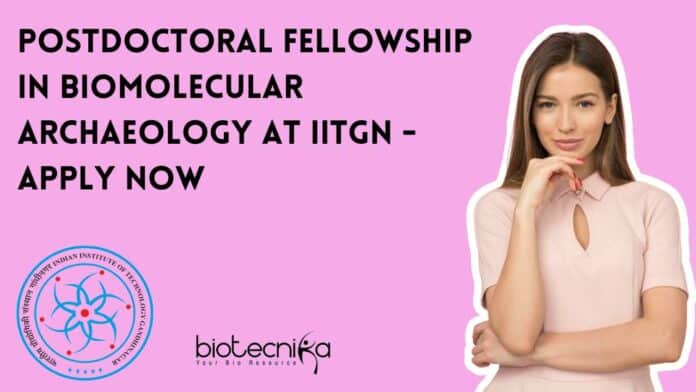Postdoctoral Fellowship at IITGN
Post doctoral Fellowship in Biomolecular Archaeology, The Indian Institute of Technology Gandhinagar (IITGN) invites applications for a Postdoctoral Fellow position funded by DST SERB POWER grant. Interested candidates can apply here.
Postdoctoral Fellowship in Biomolecular Archaeology
Location: Gandhinagar, Gujarat, India
The Indian Institute of Technology Gandhinagar (IITGN) invites applications for a Postdoctoral Fellow position funded by DST SERB POWER grant.
Job description: The successful applicant will play an active role in developing a vibrant research program and laboratory facilities dedicated to compositional and characterization techniques (X-Ray Fluorescence, X-Ray Diffraction, Fourier transform Infrared Spectroscopy), microscopy (Stereo, scanning electron and/or transmission), collagen mass fingerprinting (Zooarchaeology by Mass Spectrometry- ZooMS) and multi element stable isotope applications to modern and archaeological faunal remains and datasets. The applicant must be highly self-motivated, independent, and interested in working within interdisciplinary teams consisting of archaeologists and diverse scientists to investigate and reconstruct past human-animal interactions. The fellow will receive training and mentorship in Archaeology and Osteoarchaeology.
Duration: The initial appointment will be for 1 year, extendable for one more year based on performance.
Application procedure: Please direct all questions to Prof. Sharada Visweswara Channarayapatna ([email protected]). Candidates must e-mail the following documents as a single PDF file attachment to Prof. Sharada Visweswara Channarayapatna on or before 20th July 2023.
- CV containing scholastic record and publications.
- Cover letter stating a potential starting date and expressing your experience, suitability and interest in the topic of the project.,
- 1-page document describing previous research accomplishments and long-term goals, and
- contact details of at least 3 references. Applications will continue to be screened until a suitable candidate is selected.
Remuneration: INR 50,000 to 60,000 per month, depending on qualifications and experience.
Eligibility: Candidates must hold a Ph.D. in Archaeozoology/ Osteoarchaeology/Biology/ Zoology/Chemistry/Biochemistry/Isotope Geochemistry/ Archaeological Sciences from recognized institutions/universities with good academic track record and publications. Candidates who have submitted their thesis are also eligible. Candidates should demonstrate proficiency in sample preparation for analyses, laboratory procedures and analytics, handling relevant equipment (microscopes, Mass Spectrometers etc) and interpret results. They should have sufficient knowledge of statistical analysis and/or bioinformatics (for eg. RStudio/Matlab). Interest in Archaeological Sciences and fieldwork is desirable but not essential. Excellent oral and written skills in English is a must.
APPLY VIA YOUR LINKEDIN ACCOUNT
Here are some interview questions and answers for the Postdoctoral Fellowship opening at IITGN
- Can you describe your research experience in biomolecular archaeology and its relevance to this position? Answer: I have extensive research experience in biomolecular archaeology, specifically in the analysis and characterization of faunal remains using various techniques such as X-Ray Fluorescence, X-Ray Diffraction, Fourier transform Infrared Spectroscopy, and collagen mass fingerprinting (Zooarchaeology by Mass Spectrometry – ZooMS). My research has focused on investigating past human-animal interactions through the analysis of archaeological faunal datasets. I have a strong understanding of laboratory procedures, sample preparation, and data interpretation in this field.
- How have you collaborated with interdisciplinary teams in your previous research projects? Answer: Collaboration with interdisciplinary teams has been an essential aspect of my research. I have worked closely with archaeologists, biologists, chemists, and other scientists to integrate multiple perspectives and approaches in studying past human-animal interactions. These collaborations have allowed me to gain valuable insights and develop a comprehensive understanding of the archaeological and biomolecular aspects of my research. I believe that interdisciplinary teamwork is crucial for advancing knowledge in this field.
- Could you describe a challenging research problem you encountered and how you resolved it? Answer: During my research, I encountered a challenging problem when analyzing complex faunal datasets using statistical analysis. The data consisted of multiple variables, and I needed to identify patterns and relationships within the dataset. To overcome this challenge, I took a systematic approach by consulting with statisticians and utilizing software such as RStudio and Matlab. Through careful analysis and interpretation of the data, I was able to identify significant patterns and draw meaningful conclusions. This experience strengthened my statistical analysis skills and demonstrated my ability to tackle complex research problems effectively.
- How would you contribute to the development of a vibrant research program and laboratory facilities in biomolecular archaeology? Answer: I would contribute to the development of a vibrant research program and laboratory facilities by leveraging my expertise in compositional and characterization techniques, microscopy, collagen mass fingerprinting (ZooMS), and multi-element stable isotope applications. I would actively participate in designing research projects, acquiring necessary equipment, and establishing protocols for sample preparation and analysis. Additionally, I would collaborate with colleagues and students, providing training and mentorship in archaeology and osteoarchaeology. By fostering a collaborative and productive research environment, I aim to enhance the overall capabilities and reputation of the research program and laboratory facilities.
- Can you discuss a recent publication or research project you were involved in? Answer: One of my recent publications focused on the analysis of faunal remains from a significant archaeological site. In this project, we applied X-Ray Fluorescence and collagen mass fingerprinting techniques to examine the diet and cultural practices of past human populations. The study revealed intriguing patterns in the elemental composition of animal bones and provided insights into ancient dietary preferences and trade networks. The publication contributed to the broader understanding of human-animal interactions in that specific region and period. This project showcases my expertise in biomolecular archaeology techniques and my ability to contribute to meaningful research outcomes.
ALL THE BEST!
Editor’s Note: Please ensure you are subscribed to the Biotecnika Times Newsletter and our YouTube channel to be notified of the latest industry news. Follow us on social media like Twitter, Telegram, Facebook

























